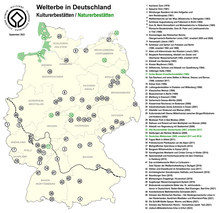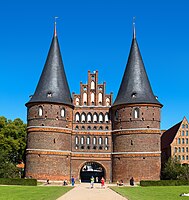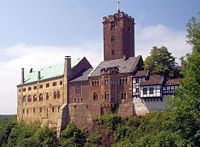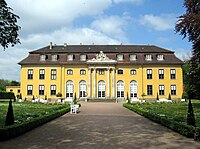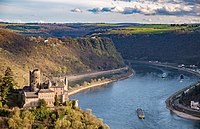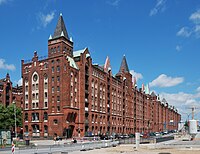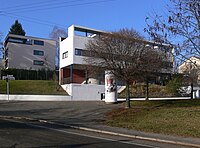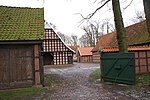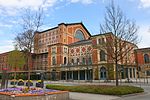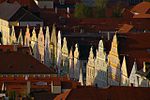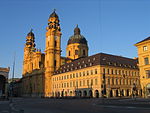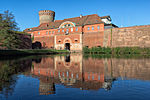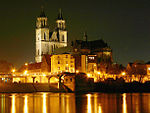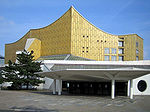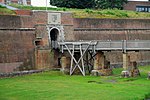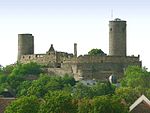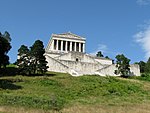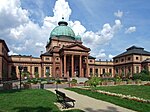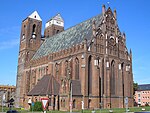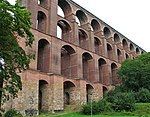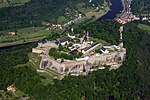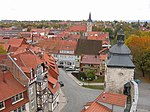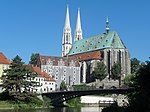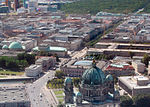World Heritage in Germany

The world heritage in Germany includes (as of 2019) 46 UNESCO world heritage sites , including 43 world cultural heritage sites and 3 world natural heritage sites. Six of these sites are cross-border or transnational .
The Federal Republic of Germany ratified the World Heritage Convention in 1976. In 1978, the Imperial Cathedral in Aachen was the only site in Germany to be one of the twelve World Heritage sites with which the World Heritage List was opened. The German Democratic Republic signed the contract in 1988. The palaces and gardens of Potsdam nominated for 1990 were included in the World Heritage List together with areas of Berlin as palaces and parks of Potsdam and Berlin at the meeting in December 1990, ie already after reunification . In 2019, the Ore Mountains and the Augsburg water management system were the last sites in Germany to be entered on the World Heritage List. Germany is the second and so far last country in which the World Heritage title has been revoked from a site ( Dresden Elbe Valley , World Heritage 2006–2009).
In Germany, applications for nominations for UNESCO World Heritage sites are submitted by the federal states. The changing locations of the World Heritage Committee included Berlin in 1995 and Bonn in 2015 .
General
legal framework
Both German states signed the Convention Concerning the Protection of the World Cultural and Natural Heritage ( World Heritage Convention ) before reunification , the Federal Republic on August 23, 1976 and the GDR on December 12, 1988. The legal binding force of the convention for Germany is until not fully clarified today. In the Federal Republic of Germany, after ratification in 1976 , it was assumed that a corresponding treaty law within the meaning of Article 59, Paragraph 2, Clause 1 of the Basic Law would have given the convention national validity. In fact, however, there is still no such contract or consent law, which leads the overwhelming opinion in the literature to the view that the World Heritage Convention is only an administrative agreement within the meaning of Article 59, Paragraph 2, Sentence 2 of the Basic Law and therefore not a "real" one. Transformation into national law has taken place, which, according to UNESCO representatives, represents a sensitive loophole.
The obligations under international law entered into by the Federal Republic of Germany when it joined the Convention must nonetheless be observed by all state bodies, including the courts and municipalities (the Basic Law is friendly to international law). In March 2008, the Federal Government of Merkel even denied any loophole in the regulation by stating: “The World Heritage Convention was ratified in 1976 in accordance with ... the so-called ' Lindau Agreement ', i. H. the federal states gave their consent at that time. This means that the federal states are also bound by the World Heritage Convention. ”However, the legal validity of the Lindau Agreement is controversial, since it (see there) may not be constitutional.
With the reunification in 1990, the validity of the World Heritage Convention was extended to the acceding area (former GDR), where, however, the convention had already been adopted by the State Council of the GDR in the spring of 1989 and came into force. In the Unification Treaty, however, their validity for the accession area was not explicitly agreed because it was not included in Annex II. Thus there is another "question mark" behind the quotation from the federal government, since the new federal states did not yet exist in 1976.
In connection with the Dresden Waldschlößchenbrücke , the Federal Constitutional Court came to the conclusion that the World Heritage Convention
"... according to the conception and wording [offers] no absolute protection against any change. In view of [the] international legal framework, it is constitutionally possible that the will of the citizen determined in a formal vote… prevails in a conflict over the planning development of a cultural landscape. ... As a consequence, the possible disadvantages from the decision - such as the loss of the world heritage status and the associated loss of reputation - must be accepted. "
Organizational framework
The protection and maintenance of monuments is a matter for the German federal states . Possible applications for inclusion in the World Heritage List are initially processed by the designated World Heritage site in cooperation with the department responsible for monument matters in the relevant federal state. The Standing Conference of Ministers of Education and Cultural Affairs (KMK) amalgamates the proposals from the federal states into a uniform German proposal list ( tentative list ). After approval by the Conference of Ministers of Education and Cultural Affairs, the tentative list will serve as the basis for Germany's future nominations for the UNESCO World Heritage List. It is submitted to the UNESCO World Heritage Committee for decision by the state authorities responsible for the preservation of monuments, the KMK Secretariat, the Foreign Office and the UNESCO World Heritage Center in Paris.
Germany was a member of the World Heritage Committee from 1976 to 1978, 1980 to 1987, 1991 to 1997. It presided over from 1995 to 1996. In 2011 Germany was re-elected to the World Heritage Committee. The German delegation is headed by the Foreign Office as the responsible department for cooperation between Germany and UNESCO. The KMK appoints a delegate to represent the federal states for the cultural sector at the UNESCO World Heritage Committee.
The task of the German UNESCO Commission (DUK) , an intermediary organization for foreign cultural policy, is to advise the Federal Government and the other competent bodies on UNESCO matters, to work on the implementation of the UNESCO program in Germany, and to inform the public about the work of the To inform UNESCO and to bring institutions, professional organizations and experts into contact with UNESCO. The German UNESCO Commission participates in the implementation of the World Heritage Convention in Germany and works closely with all bodies responsible for World Heritage.
UNESCO World Heritage Sites Germany acts as the “ umbrella organization ” for the tourist marketing of the World Heritage sites. V. with
- the German UNESCO Commission (DUK),
- the German National Tourist Board (DZT),
- the German Foundation for Monument Protection (DSD),
- local tourism organizations and
- Representatives of individual world heritage sites
as full members as well as with a few supporting members. The association was founded in 2001 and has its office in Quedlinburg in the Salfeldtschen Palais .
World Heritage Day
The UNESCO World Heritage Day in Germany was initiated by the German UNESCO Commission and the UNESCO World Heritage Site Germany e. V. launched. It has been celebrated every year since 2005 on the first Sunday in June with events at all World Heritage sites .
The central event for the German UNESCO World Heritage Day 2017 took place on June 4, 2017 in the Königsstuhl National Park Center in Sassnitz . In 2018, Aachen Cathedral was the center of the series of events. In 2020, due to the COVID-19 pandemic, the World Heritage sites were largely digital.
tourism
While in the context of the Dresden bridge dispute ( see below ) it was often argued that the World Heritage title had no significant tourist-economic effect on the municipality and the local companies, this is assessed more differently across Germany. Some sites, such as the old town of Stralsund and the monastery island of Reichenau , had a clearly positive influence on the flow of visitors.
Conflict cases
Despite the incomplete legal basis , a violation of the World Heritage Convention has so far been successfully prevented in most cases - especially in the awareness of the tourism-promoting importance of the UNESCO title . Only the Cologne Cathedral and the Dresden Elbe Valley were openly confronted with the protection goals of UNESCO (see # Cologne Cathedral (Red List 2004–2006) and #Dresdner Elbe Valley (Red List from 2006, deleted 2009) below). While local politics in Cologne relented after some time under pressure from the world organization and the conflict was resolved, the Dresden case ended with the withdrawal of World Heritage status.
National UNESCO World Heritage Site Investment Program
The Federal Ministry of Transport, Building and Urban Development launched the “Investment Program National UNESCO World Heritage Sites” at the beginning of 2009 in connection with the I economic stimulus package . In this program, a total of 220 million euros in federal funds are available for the German UNESCO World Heritage Sites from 2009 to 2014. Funding is provided for investment and conceptual measures that serve to maintain, renovate or further develop the World Heritage Sites. This includes the renovation of palaces, castles, individual buildings, industrial monuments and world-class landscape parks as well as the implementation of urban development measures in their vicinity or the creation of touristic guidance systems. Another goal of the investment program is to intensify the professional exchange between the World Heritage sites. The 2009 and 2010 funding projects were selected on the recommendation of an independent commission of experts.
The criteria were:
- Urban planning (significance in terms of urban development policy, impact on the cityscape, architectural quality)
- Preservation of monuments (conservation and restoration measures, reversibility of fixtures, compatibility of fixtures)
- Additional aspects (urgency, feasibility, sustainability of uses, role model effect, innovative character, energetic aspects, economic effect)
The Federal Ministry of Transport, Building and Urban Development is funding a total of 213 projects in 60 World Heritage municipalities and UNESCO World Heritage sites with the funds from the National UNESCO World Heritage Site investment program.
World heritage sites
Current world heritage sites
The following table lists the UNESCO World Heritage sites in Germany in chronological order according to the year of their inclusion in the World Heritage List (K - cultural heritage, N - natural heritage, K / N - mixed, (R) - on the red list of endangered world heritage ).
![]() Map with all coordinates of World Heritage Sites: OSM
Map with all coordinates of World Heritage Sites: OSM
| image | designation | year | Type | Ref. | description |
|---|---|---|---|---|---|
|
Aachen Cathedral ( location ) |
1978 | K | 3 | One of the most architecturally outstanding buildings of the Carolingian Renaissance ; The Aachen Cathedral Treasure is one of the most important church treasures in Northern Europe. From 936 to 1531 31 German kings and emperors were crowned in the cathedral.
Heritage criteria met : i, ii, iv, vi |
|
|
Speyer Cathedral ( location ) |
1981 | K | 168 | One of the world's most important Romanesque buildings from the time of the Holy Roman Empire (the world's largest surviving Romanesque church) and the house and grave church of the Salian imperial family.
Heritage criteria met : ii |
|
|
Würzburg Residence and Hofgarten ( location ) |
1981 | K | 169 | The Würzburg Residence , together with the court garden behind it and the Residenzplatz in front of it , is an important testimony to the European Baroque.
Fulfilled criteria for cultural heritage : i, iv |
|
|
Pilgrimage church "Die Wies" ( location ) |
1983 | K | 271 | The pilgrimage church on the Wies in Steingaden is an outstanding testimony to the specifically Bavarian Rococo architecture.
Heritage criteria met : i, iii |
|
| Augustusburg and Falkenlust palaces in Brühl | 1984 | K | 288 | The castles of Augustusburg ( Lage ) and Falkenlust ( Lage ) in Brühl are significant examples of the Rococo style in Germany and outstanding examples of large palace buildings from the 18th century.
Fulfilled criteria for cultural heritage : ii, iv |
|
| Cathedral and Michaeliskirche in Hildesheim | 1985 | K | 187 | The St. Mary's Assumption Cathedral ( Lage ) and the Michaeliskirche ( Lage ) in Hildesheim are significant examples of Ottonian-Romanesque architecture and visual art
Heritage criteria met : i, ii, iii |
|
|
Roman monuments, cathedral and Church of Our Lady in Trier ( location ) |
1986 | K | 367 | An outstanding testimony to the Roman epoch of Trier , especially an outstanding example of a great Roman capital after the division of the empire. The Roman Trier ( Augusta Treverorum ) includes the Porta Nigra , the amphitheater , the Kaiserthermen , the Constantine basilica , the Barbarathermen and the Roman Bridge .
Heritage criteria met : i, iii, iv, vi |
|
|
Hanseatic City of Lübeck ( location ) |
1987 | K | 272 | An outstanding example of the Hanseatic cultural heritage ; By including various Hanseatic cities in the World Heritage List, an attempt is made to testify to the history of the Hanseatic League in its entirety. The world heritage area includes: the Jakobikirche , the Holy Spirit Hospital , the cathedral , the Holstentor , the Kaisertor and the salt store on the left bank of the Trave. It is the largest area monument of the German world heritage.
Fulfilled criteria for cultural heritage : iv |
|
| Palaces and parks of Potsdam and Berlin | 1990 | K | 532 | A large-scale cultural landscape with worldwide outstanding palace and park facilities
1990: First among other things, were the castle and the Sanssouci Park and the Peacock Island with its castle inscribed on the World Heritage List |
|
|
Lorsch Abbey ( location ) |
1991 | K | 515 | An outstanding architectural testimony from the Carolingian era and one of the largest imperial monasteries in the Franconian Empire
Heritage criteria met : iii, iv |
|
| Rammelsberg mine, old town of Goslar and Upper Harz water management | 1992 | K | 623 | The Rammelsberg ore mine is a globally outstanding ensemble of mining history; no other mine has been in continuous operation for over 1000 years. 1992: First, the Rammelsberg mine and the old town of Goslar were added to the World Heritage List |
|
|
Old town of Bamberg ( location ) |
1993 | K | 624 | An outstanding example of an early medieval city in Central Europe. The world heritage area includes the three historic city centers Bergstadt (including St. Peter and St. Georg Cathedral , Alte Hofhaltung and Böttingerhaus ), Inselstadt (including the Old Town Hall and Little Venice ) and Gärtnerstadt.
Heritage criteria met : ii, iv |
|
|
Maulbronn monastery complex ( location ) |
1993 | K | 546 | The best preserved medieval monastery north of the Alps
Heritage criteria met : ii, iv |
|
|
Collegiate Church, Castle and Old Town of Quedlinburg ( location ) |
1994 | K | 535 |
Quedlinburg is an outstanding example of a medieval city in Europe due to the numerous half-timbered houses that have been preserved to this day in high quality; there is also a world-famous church treasure in the collegiate church.
Heritage criteria met : iv |
|
|
Völklinger Hütte ( location ) |
1994 | K | 687 | A globally significant testimony to industrial history; all phases of pig iron production can be traced here at the authentic location.
Cultural heritage criteria met : ii, iv |
|
|
Messel Pit ( location ) |
1995 | N | 720 | The fossil site of the Messel Pit is one of the world's most important testimonies that document the history of the vertebrate evolution
Natural heritage criteria met : vii |
|
|
Cologne Cathedral ( location ) |
1996 | K | 292 | Particularly impressive is the unique harmonization of all building elements and the jewelry in the style of medieval-Gothic architecture.
Heritage criteria met : i, ii, iv |
|
| The Bauhaus and its sites in Weimar, Dessau and Bernau | 1996 | K | 729 | Significant evidence that represents the Bauhaus style , one of the most important design and architectural styles of the 20th century, in the cities of Weimar , Dessau and Bernau . 1996: First the Bauhaus Dessau , the Masters' Houses and the model house "Am Horn" were added to the World Heritage List |
|
| Luther memorials in Eisleben and Wittenberg | 1996 | K | 783 | Outstanding evidence of one of the most important epochs in (church) history: the time of the Reformation and Counter-Reformation . World Heritage include: Martin Luther's birthplace and Martin Luther's Death House in Eisleben and the Luther House , the Melanchthon House , the palace church and the town church in Wittenberg .
Cultural heritage criteria met : iv, vi |
|
| Classic Weimar | 1998 | K | 846 | Numerous buildings and parks - the most important sites of German literature - bear witness to the Weimar Classic era to this day . In the late 18th and early 19th centuries, Weimar was the cultural center of Europe.
The world heritage includes, among other things, outstanding Schiller, Goethe and Herder memorials and the Anna Amalia library .
Heritage criteria met : iii, vi |
|
|
Museum Island Berlin ( location ) |
1999 | K | 896 | A unique ensemble in the European cultural landscape, which shows the development history of modern museum architecture in an outstanding way.
The World Heritage and Museum Island include: the Pergamon Museum , the Old Museum , the Old National Gallery , the Bode Museum and the New Museum .
Cultural heritage criteria met : ii, iv |
|
|
Wartburg ( location ) |
1999 | K | 897 | One of the most historically interesting castles in Germany; it is related to numerous important personalities (including Martin Luther and Saint Elizabeth ) and events (including the translation of the New Testament into German).
Heritage criteria met : iii, vi |
|
|
Garden Kingdom of Dessau-Wörlitz ( location ) |
2000 | K | 534 | An outstanding example of landscaping in the spirit of the Enlightenment. The following palaces and parks are part of the World Heritage and Garden Kingdom : Luisium , Georgium , Mosigkau , Großkühnau , Sieglitzer Berg , Oranienbaum and Wörlitz .
Fulfilled criteria for cultural heritage : ii, iv |
|
|
Reichenau monastery island ( location ) |
2000 | K | 974 | The island in Lake Constance is an important testimony to the religious and cultural role of a large Benedictine monastery in the Middle Ages. The following important places of worship are located on the island: the Minster St. Maria and Markus , the Church of St. Peter and Paul and the Church of St. George .
Heritage criteria met : iii, iv, vi |
|
|
Industrial complex Zeche Zollverein in Essen ( location ) |
2001 | K | 975 | An important testimony to the development of heavy industry in Europe. The 12 and 1/2/8 shafts of the colliery and the Zollverein coking plant belong to the world heritage area in Essen .
Fulfilled criteria for cultural heritage : ii, iii |
|
|
Upper Middle Rhine Valley ( location ) |
2002 | K | 1066 | The uniqueness of this cultural landscape between Bingen / Rüdesheim and Koblenz is the extraordinary wealth of cultural evidence. It is the epitome of Rhine romanticism . The world heritage area includes: the Loreley , the Ehrenbreitstein fortress and the Marksburg .
Heritage criteria met : ii, iv, v |
|
| Old towns of Stralsund and Wismar | 2002 | K | 1067 | An outstanding example of the Hanse's cultural heritage . The world heritage area includes the old market and the Marienkirche in Stralsund as well as the market square and the Nikolaikirche in Wismar.
Fulfilled criteria for cultural heritage : ii, iv |
|
| Town hall and Roland in Bremen ( location ) |
2004 | K | 1087 | The town hall and the Roland statue on the market square of Bremen are significant representations of civil autonomy and sovereignty during the Holy Roman Empire.
Heritage criteria met : iii, iv, vi |
|
|
Muskauer Park (Park Muzakowski) ( location ) |
2004 | K | 1127 | An outstanding example of European horticulture and the largest English-style landscape park in Central Europe. Both the German and Polish parts of the park are part of the cultural heritage. In the historic Upper Lusatia, the park covers 3.5 km² in Poland and 2.1 km² in Germany.
Heritage criteria met : i, iv |
|
| Borders of the Roman Empire - Upper German-Raetischer Limes | 2005 | K | 430 | The Upper German-Raetian Limes is the second longest ground monument in the world after the Great Wall of China 1987: First the remains of Hadrian's Wall in Great Britain were included in the World Heritage List |
|
| Old town of Regensburg with Stadtamhof | 2006 | K | 1155 | The old town of Regensburg testifies to the history of the city as a European trading center in the Middle Ages , the political core of the Holy Roman Empire and a cultural and religious center for centuries. Today Regensburg is the largest medieval city north of the Alps . Stadtamhof , which was incorporated in 1924, is directly connected to Regensburg's old town by the Stone Bridge over the Danube .
Fulfilled criteria for cultural heritage : ii, iii, iv |
|
| Berlin Modernist Settlements | 2008 | K | 1239 | The settlements set the style for social housing after the First World War and, with their clear and new forms and social demands, were generally decisive for the architecture and urban planning of the 20th century. The world heritage includes six reform settlements that were built in Berlin at the beginning of the 20th century. These are: the garden city of Falkenberg , the Schillerpark housing estate , the Hufeisensiedlung , the Carl Legien housing estate , the White City and the Siemensstadt housing estate .
Heritage criteria met : ii, iv, v map |
|
| Wadden Sea | 2009 | N | 1314 | The world's largest Wadden Sea and a globally significant habitat for numerous animal and plant species form a cross-border natural heritage site.
2009: First, the Dutch Wadden Sea Conservation Area and the Wadden Sea National Parks in Lower Saxony and Schleswig-Holstein were added to the World Heritage List. |
|
| Old beech forests and primeval beech forests of the Carpathian Mountains and other regions of Europe | 2011 | N | 1133 | The world's most important evidence of near-natural lowland beech forests and outstanding low mountain range beech forests are part of a transnational natural heritage site . 2007: First beech forests in Slovakia and Ukraine were added |
|
| Fagus factory in Alfeld | 2011 | K | 1368 | The factory building erected by Walter Gropius and Adolf Meyer in Alfeld in 1911 is considered the original work of modern industrial architecture.
Fulfilled criteria for cultural heritage : ii, iv, v |
|
| Prehistoric pile dwellings around the Alps | 2011 | K | 1363 | The pile dwellings and the finds made there are outstanding testimonies to the history and life of the settler communities in the Neolithic and Metal Ages. In Germany, 18 sites with pile dwellings in Baden-Württemberg and Bavaria are part of the World Heritage. The world heritage also includes pile construction sites (111 in total) in the following other Alpine countries: Switzerland, France, Italy, Austria and Slovenia.
Criteria met for cultural heritage : iv, v |
|
| Margravial Opera House Bayreuth | 2012 | K | 1379 | A jewel among 18th century theaters in Europe; it is the only surviving example in which the culture and acoustics of a baroque court opera can be authentically experienced.
Criteria fulfilled for cultural heritage : i, iv |
|
| Bergpark Wilhelmshöhe | 2013 | K | 1413 | A 300 year old outstanding example of European garden art ; Nowhere else in the world is there a park with water features of comparable size; some water pipes up to 300 years old are still in use here. The world heritage area and the mountain park include: the water features, the octagon with the statue of Hercules , the Lion Castle and the Wilhelmshöhe Palace .
Criteria fulfilled for cultural heritage : ii, iv |
|
| Carolingian Westwork and Civitas Corvey | 2014 | K | 1447 | One of the most important Carolingian monasteries in the world (it has the world's oldest and only almost completely preserved westwork from the Carolingian period .); it was created in 822 and forms an outstanding connection between Carolingian architecture and ancient models.
Heritage criteria met : ii, iii, iv |
|
| Hamburger Speicherstadt and Kontorhausviertel with Chilehaus | 2015 | K | 1467 | Significant evidence of the history of (sea) trade in Hamburg :
Heritage criterion met : iv |
|
| The architectural work of Le Corbusier - an outstanding contribution to the "Modern Movement" | 2016 | K | 1321 |
Transnational world heritage sites with works by the architect Le Corbusier as significant evidence of modern architecture. In Germany, two houses in the Weißenhofsiedlung in Stuttgart are part of the world heritage : the Weissenhof Museum and the neighboring house Citrohan . In addition, the World Heritage “Le Corbusier's Architectural Work” also includes buildings in Belgium, France, India, Japan and Switzerland.
Heritage criteria met : i, ii, vi |
|
| Caves and ice age art in the Swabian Jura | 2017 | K | 1527 | The caves, the surrounding landscape and in particular the unique finds of human and animal figures and musical instruments made of ivory are unique testimonies to a prehistoric (mobile) hunter-gatherer society. The world heritage comprises a total of six caves in the Swabian Alb near Ulm , three in the Achtal ( Hohler Fels , Sirgensteinhöhle and Geißenklösterle ) and three in the Lone Valley ( Vogelherdhöhle , Bocksteinhöhle and Hohlenstein-Stadel ).
Heritage criteria met : iii |
|
| Archaeological border complex Haithabu and Danewerk | 2018 | K | 1553 |
Haithabu was an important settlement of Danish Vikings and Swedish Varangians . The place is considered an early medieval city in Northern Europe and was an important trading place and main hub for long-distance trade between Scandinavia , Western Europe , the North Sea region and the Baltic States .
The Danewerk is a spatially and temporally complex, linear fortification from the early and high Middle Ages in northern Schleswig-Holstein . It consists of earth walls with defensive trenches, a brick wall, two medieval ramparts and a lake barrier. Heritage criteria met : iii, iv
|
|
|
Naumburg Cathedral ( location ) |
2018 | K | 1470 | One of the most important cathedral buildings from the European High Middle Ages. His larger-than-life donor figures of the Naumburg master , especially the figure of Uta von Naumburg, are of outstanding importance .
Heritage criteria met : i, ii |
|
| Ore Mountains / Krušnohoří mining region | 2019 | K | 1478 | Outstanding example of a mining region in Europe, many technical monuments and other buildings connected with the mining industry have largely been preserved in their original form.
The world heritage in Saxony includes the mining and mining landscapes Freiberg , Annaberg-Frohnau , Pöhlberg , Buchholz , Eibenstock , Roter Berg , uranium ore mining, Hoher Forst, Lauta , Ehrenfriedersdorf , Schneeberg and Altenberg-Zinnwald as well as the Schindler's blue ink factory , the administrative seat of Lauenstein , the Saigerhüttenkomplex Grünthal , the historical old town Marienberg and the high medieval silver mines Dippoldiswalde and in the Czech Republic the mining towns and areas Jachymov , Red Tower of Death , Abertamy - Bozi Dar - Horní Blatná , Kupferberg and Krupka . The world heritage site is cross-border as it also includes parts of the Czech Republic. Therefore it is noted in the list under the double name Erzgebirge / Krušnohoří. Criteria for cultural heritage met : ii, iii, iv |
|
| Augsburg's historical water management | 2019 | K | 1580 | An outstanding testimony to the history of water management.
The World Heritage includes four stream and canal systems as well as 24 other historical objects and ensembles from the field of hydraulic engineering and water supply in Augsburg , including the two oldest existing waterworks and the three oldest existing water towers in Germany and probably also in Central Europe. Cultural heritage criteria met : ii, iv |
Sites marked as World Heritage
| image | designation | year | Type | Ref. | description |
|---|---|---|---|---|---|
|
( location ) |
2004-2009 | K | 1156 | Cultural landscape with numerous important baroque buildings ( Dresden Baroque ). The world heritage includes 20 km along the Elbe between Dresden-Söbrigen and Dresden-Übigau . This included u. a .: the Blue Wonder , the Elbe castles and Dresden's old town .
UNESCO removed this area from the list of world heritage sites on June 25, 2009, as the construction of the Waldschlößchenbrücke through the Elbe valley had not been stopped. |
Tentative list
The sites that are intended for nomination for inclusion in the World Heritage List are entered in the tentative list (list of proposals).
Current World Heritage candidates
As of July 2019, there are 12 sites in Germany's tentative list. The last entry was in 2018 the addition of the proposal for the limits of the Roman Empire with a separate proposal for the Lower Germanic Limes.
The Mathildenhöhe in Darmstadt and the major European baths of the 19th century have been nominated for the 44th session of the World Heritage Committee in 2020 .
The following table lists the sites in chronological order according to the year of their inclusion in the tentative list.
![]() Map with all coordinates of current World Heritage candidates: OSM
Map with all coordinates of current World Heritage candidates: OSM
| image | designation | year | Type | Ref. | description |
|---|---|---|---|---|---|
| The Francke Foundations in Halle: Orphanage and Educational Architecture | 1999 | K | 1368 | The buildings of the Francke Foundations in Halle include some of the most important buildings from the time of Pietism and the early Enlightenment in Germany. The foundation was founded in 1698 by the theologian and educator August Hermann Francke . The buildings still house numerous cultural, scientific, educational and social facilities. There are around 50 buildings.
The application for the World Heritage title was withdrawn on January 7, 2016. The award of the title can still be requested at a later date, when it is given better chances.
|
|
| Important European baths of the 19th century | 2014 | K | 5934 | Cities or spas that (should) testify to generally important aspects of medical history and especially all important aspects of the history of spa medicine.
The transnational proposal together with Belgium (Ref. 5932 ), France (Ref. 5931 ), Italy (Ref. 5928 ), Austria (Ref. 5930 ), Czech Republic (Ref. 5929 ) and the United Kingdom (Ref. 5935 ) includes in Germany Baden-Baden , Bad Kissingen and Bad Ems . The proposal belongs to the previously under-represented category of sites in the history of the spa. First of all, 16 spas should jointly achieve the world heritage title. As part of the preparations for submitting the final application to UNESCO, however, the list of cities has since been reduced. The reason for this is that the focus of the application seems to be more and more on the importance of cities as a spa and for medical history and less as a community and world spa.
|
|
|
Jewish cemetery Hamburg-Altona ( location ) |
2015 | K | 5973 | Due to its size, age and the large number of preserved tombstones, it is one of the world's most important Jewish cemeteries. The proposal belongs to the previously under-represented category of Jewish sites.
Recommendation of the advisory board to update the German tentative list for the UNESCO World Heritage: Support a serial application. This did not materialize. The nomination was withdrawn in January 2018. Instead, a later transnational application of several cities with Sephardic cemeteries is sought.
|
|
| Alpine and pre-Alpine meadows and moorlands | 2015 | K | 5974 | This proposal includes various historical cultural landscapes in the Werdenfelser Land , Ammergau , Staffelsee area and Murnauer Moos , district of Garmisch-Partenkirchen , in which a traditional form of agriculture has been preserved for the Alpine region to this day. The proposal belongs to the previously underrepresented category of cultural landscapes.
Recommendation of the Advisory Board to update the German tentative list for the UNESCO World Heritage: a more catchy title, more precise definition of the nomination area and obtaining the consent of all farmers involved
|
|
| The ShUM cities of Speyer, Worms and Mainz | 2015 | K | 5975 | The Jewish communities of the three cities of Speyer , Worms and Mainz , which were important in the Middle Ages and which cooperated with one another , are considered the birthplace of Ashkenazi religious culture. The Minhagim (customs) and Takkanot (regulations) that arose there are still in effect in Orthodox Judaism today.
The core of the application form includes the Judenhof and synagogue in Speyer , the synagogue garden and the Heiliger Sand cemetery in Worms and the Jewish cemetery in Mainz. The proposal belongs to the previously under-represented category of Jewish sites. Recommendation of the advisory board to update the German tentative list for the UNESCO World Heritage: Review of the meaningfulness of a joint nomination with the Old Synagogue and Mikveh in Erfurt - evidence of everyday life, religion and city history between continuity and change
|
|
| Residence ensemble Schwerin - cultural landscape of romantic historicism | 2015 | K | 5976 | The Schwerin palace ensemble has an extraordinarily long, epoch-spanning tradition as a historical, political and architectural central location (prince and parliament) from the 10th century to the present.
At the core of the application is Schwerin's historical and, in some cases, also the current center of power consisting of the castle , theater, museum , castle church , stables , laundry and gardens Recommendations of the advisory board for updating the German tentative list for the UNESCO World Heritage: Review of the sensibility of a serial nomination with other sites that represent the residential building of the late 19th century in an outstanding way, or with the ducal palaces Ludwigslust and Güstrow , since the proposal is integrated into one over-represented category falls
|
|
| Mathildenhöhe artists' colony in Darmstadt | 2015 | K | 5981 | A significant artistic and architectural testimony to the transition from Art Nouveau to Modernism.
The proposal includes the place of activity of the Darmstadt artists 'colony on the Mathildenhöhe with its exhibition buildings including the wedding tower , the plane grove with its garden pavilions and the sculpture garden as well as several masters' houses from the period from 1899 to 1914. The proposal belongs to the previously underrepresented category of modern sites.
|
|
| Old synagogue and mikveh in Erfurt - evidence of everyday life, religion and city history between continuity and change | 2015 | K | 5982 | One of the best preserved synagogues in Central Europe and generally outstanding evidence of medieval Jewish sacred and secular buildings
In addition to the old synagogue and the bathhouse , the proposal also includes a secular building. The sites from the 11th-13th centuries Century are all in the middle of the old town of Erfurt . The proposal belongs to the previously under-represented category of Jewish sites. Recommendation of the Advisory Board to update the German tentative list for the UNESCO World Heritage: Review of the sensibility of a joint nomination with the ShUM cities of Speyer, Worms and Mainz; otherwise more detailed elaboration of the specifics of an individual application (e.g. Jewish trade / everyday life in a medieval city)
|
|
| Built dreams - the castles Neuschwanstein , Linderhof and Herrenchiemsee of the Bavarian King Ludwig II. | 2015 | K | 5983 | The castles Neuschwanstein , Linderhof and Herrenchiemsee of the Bavarian King Ludwig II "embody in a globally unique culmination a late romantic-historicist architectural concept that represents the cultural epoch of the late 19th century in a variety of ways."
Castle buildings from the most varied of eras are overrepresented on the World Heritage List. Recommendations of the advisory board for updating the German tentative list for the UNESCO World Heritage: Do not attach the importance of the castles exclusively to the person of the "fairy tale king", a stronger positioning of the castles in their cultural-historical context, a better emphasis on the value of the existing buildings and furnishings in a worldwide comparison and the verification of the sensibility of a serial nomination with other sites that represent the residential building of the late 19th century in an outstanding way (e.g. Residenzensemble Schwerin ), since the proposal falls into an overrepresented category
|
|
| Luther sites in Eisleben and Wittenberg - Luther sites in Central Germany | 2015 | K | 5986 | Planned expansion of the Luther Memorials World Heritage Site in Eisleben and Wittenberg (Ref. 783 ) to include other sites in Wittenberg and Eisleben , the parental home and St. George's Church in Mansfeld , Hartenfels Castle in Torgau , the Coburg Fortress and the Augustinian Monastery in Erfurt
The expansion of the World Heritage was planned for 2017, but the nomination was withdrawn before the World Heritage Committee meeting.
|
|
| Borders of the Roman Empire - The Danube Limes in Austria and Bavaria | 2015 | K | 6002 | Transnational proposal, together with Austria (lead management), on the so-called Danube Limes , includes sites in Bad Gögging , Eining Weinberg , Regensburg , Pfatter-Gmünd , Straubing , Künzing and Passau ( Danube Limes ) in Germany.
On February 1, 2018, a joint application from Germany, Austria, Slovakia and Hungary was submitted to include "Borders of the Roman Empire - The Danube Limes in Austria and Bavaria" in the World Heritage List. The decision will therefore be made in July 2019 whether the Danube Limes will be recognized as a UNESCO World Heritage Site. The World Heritage Council, which advises the World Heritage Committee, recommended this site to be included in the list. Due to a last-minute change in the nomination by the Hungarian side, the examination of this nomination had to be postponed to a future meeting of the committee.
|
|
| Borders of the Roman Empire - The Lower Germanic Limes in the Netherlands, North Rhine-Westphalia and Rhineland-Palatinate | 2018 | K | 6299 | Together with the Netherlands (Ref. 6298 ) the cultural heritage site " Frontiers of the Roman Empire - Lower Germanic Limes " is being developed. On the German side, the proposal includes 27 areas along the Rhine between Remagen and Bedburg-Hau . |
Former World Heritage candidates
These sites were previously on the tentative list, but were withdrawn or rejected by UNESCO. Sites that are included in other entries on the tentative list or that are part of world heritage sites are not taken into account here.
Germany originally put a large number of individual cultural and natural monuments on the tentative list, e.g. B. individual churches, monasteries, castles, etc., without paying attention to their universal meaning. At its 17th meeting in December 1993, the World Heritage Committee decided to evaluate annually from 1994 onwards which tentative lists correspond to the Operational Guidelines. As early as 1993, Germany deleted some sites from the tentative list. In the evaluation of 1994, the revised tentative list of Germany was also classified as not meeting the requirements. As a result, when the list was revised in 1996, numerous sites were deleted and only eleven particularly significant monuments were left on the list, which, with the exception of one, were included in the World Heritage List in the following years.
![]() Map with all coordinates of former World Heritage candidates: OSM
Map with all coordinates of former World Heritage candidates: OSM
| image | designation | year | Type | Ref. | description |
|---|---|---|---|---|---|
|
Elisabeth Church in Marburg ( location ) |
1980-1996 | K | The construction of the Elisabethkirche in Marburg began in the year of Elisabeth's canonization (1235) and it was consecrated in 1283 | ||
|
Artland - landscape with farms ( location ) |
1984-1993 | K | The Artland landscape extends over the joint municipality of Artland and the municipality of Gehrde in the district of Osnabrück . | ||
|
Maximilianstrasse in Augsburg ( location ) |
1984-1993 | K | Boulevard in Augsburg with the cathedral , town hall and the St. Ulrich and Afra basilica | ||
|
Bayreuth Festival Hall ( location ) |
1984-1993 | K | Opera house in Bayreuth built in the style of Hellenistic Romanticism based on designs by Richard Wagner | ||
| Danube valley around Regensburg | 1984-1993 | K | Cultural landscape in the valley of the Danube around Regensburg including the Walhalla and the Donaustauf | ||
| Danube valley around Weltenburg | 1984-1993 | K | Cultural landscape in the valley of the Danube around the Weltenburg monastery | ||
| Old town of Landshut | 1984-1993 | K | with the Trausnitz Castle | ||
| Town hall Lueneburg | 1984-1993 | K | |||
| Main valley between Banz and Vierzehnheiligen | 1984-1993 | K | Cultural landscape in the valley of the Main between Banz Monastery and the Basilica Vierzehnheiligen | ||
| Maria Laach | 1984-1993 | K | with the abbey church and the Laacher See | ||
| Ludwigstrasse in Munich | 1984-1993 | K | Boulevard in Munich with Odeonsplatz , Residenz , Feldherrnhalle and Theatinerkirche | ||
| Ottobeuren monastery | 1984-1993 | K | |||
| Old town of Passau | 1984-1993 | K | |||
| Rothenburg, Nördlingen, Dinkelsbühl | 1984-1993 | K | includes the cities of Rothenburg ob der Tauber , Nördlingen and Dinkelsbühl with a well-preserved medieval townscape. | ||
| Federal fortress Ulm | 1984-1993 | K | |||
| Wolfenbüttel | 1984-1993 | K | |||
| Worms Cathedral | 1984-1993 | K | |||
| Spandau Citadel in Berlin | 1984-1996 | K | |||
| Brunswick lion | 1984-1996 | K | |||
| Eberbach Monastery | 1984-1996 | K | |||
|
Eltz Castle ( location ) |
1984-1996 | K | |||
| Externsteine | 1984-1996 | N | |||
| Freiburg Minster | 1984-1996 | K | The Minster of Our Lady is the Roman Catholic parish church of Freiburg im Breisgau, built in the Romanesque and largely Gothic style. It was built between 1200 and 1513. | ||
| Nymphenburg Palace in Munich | 1984-1996 | K | with the castle park | ||
| Weingarten Abbey | 1984-1996 | K | |||
| Kaiserpfalz Gelnhausen | 1984-1996 | K | |||
| Ludwigsplatz in Saarbrücken | 1984-1996 | K | |||
| Weißenstein Castle in Pommersfelden | 1984-1996 | K | |||
|
Magdeburg Cathedral St. Mauritius and Katharina ( location ) |
1990 1996-1999 |
K | Magdeburg Cathedral, Otto the Great's grave church , is the oldest Gothic building on German soil.
Originally proposed by the German Democratic Republic, Magdeburg Cathedral was included in the all-German tentative list in 1996. In 1990 and 1999 it was nominated for inclusion in the World Heritage, but was withdrawn both times before the World Heritage Committee meeting. |
||
|
Armory in Augsburg ( location ) |
1993-1996 | K | Built between 1602 and 1607 by Elias Holl as a weapon arsenal and accommodation for up to 3000 soldiers. | ||
| AEG turbine factory in Berlin | 1993-1996 | K | |||
| Berlin Philharmonic | 1993-1996 | K | |||
| Goethe House in Frankfurt | 1993-1996 | K | Home of the Goethe family on the Großer Hirschgraben in Frankfurt am Main , where the poet Johann Wolfgang von Goethe was born in 1749 . | ||
| Paulskirche in Frankfurt | 1993-1996 | K | |||
| Jülich Fortress | 1993-1996 | K | |||
|
Königsplatz in Munich ( location ) |
1993-1996 | K | Place in Munich 's Maxvorstadt district on the Brienner Strasse train, Munich 's first boulevard | ||
| Munzenberg Castle | 1993-1996 | K | |||
| Roman villa by Nennig | 1993-1996 | K | Excavation site in Nennig in Saarland with a well-preserved floor mosaic from the 3rd century AD. | ||
| Walhalla near Regensburg | 1993-1996 | K | |||
| Hölderlin Tower in Tübingen | 1993-1996 | K | House in Tübingen , where the poet Friedrich Hölderlin lived from 1807 until his death in 1843. Part of the house was built on the base of a tower in the medieval city wall. | ||
| Gardens and estates in and around Kassel | 1999-2013 | K | 1365 | In addition to the Bergpark Wilhelmshöhe (Ref. 1413 ), which was added to the World Heritage List in 2013 , the proposal also included Friedrichplatz ( Lage ) in Kassel and Schloss Wilhelmsthal ( Lage ) in Calden . | |
| Heidelberg Castle and Old Town | 1999-2014 | K | 1359 | The ruins of Heidelberg Castle are one of the most famous ruins in Germany. Together with Heidelberg's baroque old town and the surrounding nature, Heidelberg made it a center of romanticism in the 19th century.
At its 31st meeting on June 29, 2007 in Christchurch, New Zealand, the UNESCO World Heritage Committee referred the World Heritage application back to the applicant for the second time since 2005. |
|
| Schwetzingen: A summer residence in the Electoral Palatinate - garden design and masonic allusions | 1999-2014 | K | 1361 | Summer residence of the Palatinate Electors Karl Philipp and Karl Theodor
At its 36th meeting in June / July 2012 in St. Petersburg, Russia, the UNESCO World Heritage Committee referred the application back to the applicant. |
|
| Important European baths of the 19th century | 2014-2016 | K | 5934 |
Bad Homburg vor der Höhe , Wiesbaden and Bad Pyrmont are no longer included in the proposal.
|
|
| The Naumburg Cathedral and the high medieval cultural landscape on the Saale and Unstrut. | 2015-2017 | K | 1369 | One of the world's most important (cultural) landscapes, which testify to the time of the High Middle Ages; (Almost) nowhere else is there an area with such a high density of high medieval fortifications, secular and sacred buildings
The core of the application included: the old town of Naumburg , the castle complex Schönburg , the monastery church and palace complex Goseck, the Romanesque house Bad Kösen , the Rudelsburg , the old town Freyburg with the Marienkirche and the castle Neuchâtel . In 2018, only the Naumburg Cathedral was declared a World Heritage Site at the suggestion of ICOMOS. |
|
| Ore Mountains / Kruśnohoří mining region | 2012-2018 | K | 5776 | In the course of revising the previous application, the number of components in the application was reduced from 79 to 22 (17 in Saxony, 5 in the Czech Republic). Only objects that are directly connected to ore mining and mining processes or mining landscapes are part of the World Heritage site. The majority of the painted objects are integrated into the world heritage landscape as “associated components / objects”. These can be viewed at: Associated sites . |
World Heritage candidates of the former GDR
In 1989 the German Democratic Republic nominated five sites for inclusion in the World Heritage for the first time: Potsdam Palaces and Gardens, Dresden Baroque Ensemble, Dessau-Wörlitz Cultural Landscape, Quedlinburg Castle / Collegiate Church and Magdeburg Cathedral, but withdrew the applications in 1990. In a list from 1990, in addition to the five mentioned, another 30 proposals for the World Heritage List are listed. After the reunification of Germany in 1990, only some of these proposals were included in the all-German tentative list. The sites not taken over include:
| image | designation | year | Type | Ref. | description |
|---|---|---|---|---|---|
|
Prenzlau, Marienkirche ( location ) |
1990 | K | (08.) | ||
|
Gernrode, women's collegiate church ( location ) |
1990 | K | (09.) | ||
|
Heidenau, Großsedlitz Baroque Garden ( location ) |
1990 | K | (11.) | ||
|
Obercunnersdorf, village complex ( location ) |
1990 | K | (12.) | ||
|
Oberspreewald, with village facilities ( location ) |
1990 | K | (13.) | ||
|
Ohrdruf, Tobiashammer ( location ) |
1990 | K | (15.) | Hydro-powered forging hammer facility in Ohrdruf , technical monument and museum since 1983. | |
|
Netzschkau, Göltzschtalbrücke ( location ) |
1990 | K | (16.) | ||
|
Berlin, Friedrichshagen waterworks ( location ) |
1990 | K | (17.) | ||
|
Königstein, fortress ( location ) |
1990 | K | (18.) | ||
| Erfurt, Cathedral and St. Severi | 1990 | K | (19.) | The cathedral ( location ) and the Severikirche ( location ) in Erfurt are located directly next to each other on the Domberg and together form a symbol of the city. | |
|
Weimar, Buchenwald ( location ) |
1990 | K | (21.) | The Buchenwald concentration camp was one of the largest concentration camps on German soil. | |
|
Halberstadt, cathedral ( location ) |
1990 | K | (22.) | ||
|
Fürstenberg, Ravensbrück ( location ) |
1990 | K | (23.) | ||
|
Mühlhausen, Thomas-Müntzer-Stadt ( location ) |
1990 | K | (24.) | Workplace of the reformer and revolutionary Thomas Müntzer during the Peasant War | |
|
Görlitz, old town ( location ) |
1990 | K | (25.) | ||
| Meissen, Cathedral and Albrechtsburg | 1990 | K | (26.) | The cathedral ( location ) and the Albrechtsburg ( location ) in Meißen are located together on the castle hill rising above the old town of Meißen | |
|
Bad Doberan, Münster ( location ) |
1990 | K | (28.) | Former monastery church of Doberan Monastery , today the church of the Evangelical Lutheran Parish Bad Doberan , one of the most important Gothic brick buildings in the Baltic Sea region along the European Route of Brick Gothic . | |
|
Berlin, Gendarmenmarkt ( location ) |
1990 | K | (29.) | ||
|
Berlin, Ensemble Unter den Linden ( location ) |
1990 | K | (30.) | ||
|
Jerichow, Premonstratensian Collegiate Church ( location ) |
1990 | K | (33.) | Monastery church of the Jerichow Monastery | |
|
Wittenberg, old town ( location ) |
1990 | K | (34.) | Originally, the entire historic city center of Lutherstadt Wittenberg was proposed. However, only the Luther memorials (Ref. 783 ) were included in the world heritage . |
Endangered and former world heritage sites
Cologne Cathedral (Red List 2004–2006)
In July 2004, Cologne Cathedral was added to the Red List of World Heritage in Danger. The city of Cologne initially continued its construction policy in the vicinity of the cathedral. In talks between UNESCO and the city administration, an agreement was finally reached: a free zone on both sides of the Rhine will protect the cathedral from now on. In addition, buildings near the free zone should not exceed a height of 60 meters. Thus, the cathedral was removed from the red list in July 2006.
Dresden Elbe Valley (Red List from 2006, deleted in 2009)
The Dresden Elbe Valley was entered on the Red List in July 2006 because, according to the expert report, the four-lane Waldschlößchenbrücke “irreversibly divides the contiguous landscape of the Elbe arch into two halves at the most sensitive point [...]”. The basis for the bridge construction is a referendum from February 2005, which was binding until February 2008. Based on this, the state government ensured that the construction of the bridge according to the 1997 design began in November 2007, although the Dresden city council tried to find a compromise solution. The invitation of UNESCO to submit an alternative plan by October 2007, have not been met, instead, the state government prompted the start of construction by substitute performance .
In January 2008, minor rescheduling was presented, but the UNESCO did not convince.
In March 2008, the federal government stated : "Removing the Dresden Elbe Valley from the World Heritage List would significantly affect Germany's reputation and Germany's relationship with UNESCO." Independently of this, the Waldschlößchenbrücke was continued. As a result, the Dresden Elbe Valley lost the title of World Heritage Site due to a decision by the World Heritage Committee on June 25, 2009. After the wildlife sanctuary in the Oman desert in 2007, it was the second deletion of a World Heritage site from the UNESCO list. A new application of the site with changed borders and with reference to other criteria was not ruled out.
Threats to other sites
In all other previous conflict cases, (potential) threats were averted at an early stage. For example, thanks to local and regional efforts at the Wartburg and thanks to timely coordination with UNESCO in Stralsund , where one of the largest German road bridges, the Rügen Bridge, was built a few hundred meters from the historic old town in 2004–2007 - not for aesthetic reasons as an inexpensive girder bridge, but as a more expensive cable-stayed bridge.
In the World Heritage cultural landscape of the Upper Middle Rhine Valley , UNESCO viewed the planned Middle Rhine Bridge and the Koblenz cable car critically in the past . Both are currently no longer a problem, as the construction of the bridge is no longer being pursued and the operation of the cable car on June 19, 2013 in Phnom Penh was allowed until 2026 at the 37th meeting of the World Heritage Committee. However, at the same meeting, UNESCO called for the Loreley summer toboggan run to be dismantled .
Postage stamps and coins
Stamp series
As part of the UNESCO World Heritage stamp series , Deutsche Bundespost has been issuing special stamps with World Heritage sites as a motif since 1990. Most of these brands show world heritage sites from Germany, but also some from other countries. The motifs from Germany include:
Values in pennies:
- 1990 Lübeck old town (100)
- 1996 Old Völklinger Hütte (100)
- 1996 Bamberg old town (100)
- 1997 Palaces of Augustusburg and Falkenlust (100)
- 1998 Maulbronn Monastery (100)
- 1998 Messel Pit (110)
- 1998 Würzburg Residence (110)
Values in euro cents
- 2002 Garden Kingdom of Dessau-Wörlitz (56)
- 2002 Museum Island Berlin (56)
- 2003 Cologne Cathedral (55)
- 2003 Bauhaus sites in Weimar and Dessau (55)
- 2006 Upper Middle Rhine Valley (55)
- 2007 Stralsund and Wismar (70)
- 2007 Limes (block edition) (55)
- 2008 Reichenau monastery island (45)
- 2009 Luther memorials in Eisleben and Wittenberg (145)
- 2010 St. Michaelis Hildesheim (220)
- 2011 Old Town Regensburg (75)
- 2012 Muskauer Park (90)
- 2014 Fagus factory (60)
- 2016 Corvey Monastery (70)
- 2017 Rammelsberg mine, old town of Goslar and Upper Harz water management (145)
Commemorative coins
Since 2003, the German 100 euro gold commemorative coins (with an interruption in 2005 because of the commemorative coin for the 2006 FIFA World Cup ) have shown World Heritage sites in Germany as a motif. The following sites have been taken into account so far (designation according to the coinage):
- 2003 World Heritage City of Quedlinburg
- 2004 City of Bamberg
- 2006 Classic Weimar
- 2007 Hanseatic City of Lübeck
- 2008 Old Town · Rammelsberg mine, Goslar
- 2009 Roman monuments - Cathedral and Church of Our Lady in Trier
- 2010 Würzburg Residence and Court Garden
- 2011 Wartburg
- 2012 Aachen Cathedral
- 2013 Garden Kingdom of Dessau-Wörlitz
- 2014 Lorsch Monastery
- 2015 Upper Middle Rhine Valley
- 2016 Old town of Regensburg with Stadtamhof
- 2017 Eisleben and Wittenberg Luther Memorials
- 2018 Palaces of Augustusburg and Falkenlust
See also
Other forms of UNESCO cultural and natural heritage in Germany:
- List of biosphere reserves in Germany
- List of UNESCO Global Geoparks in Europe # Germany
- World document heritage in Germany
Web links
- Germany on the website of the UNESCO World Heritage Center.
- World Heritage Sites in Germany (German UNESCO Commission e.V.)
- Ways to World Heritage an interactive offer from Deutsche Welle in 18 languages. Eight tourist routes lead to the 38 German world heritage sites.
- UNESCO World Heritage Sites Germany V. - joint tourism portal of the world heritage sites
- National UNESCO World Heritage Site Investment Program - Information on the World Heritage Program
- All UNESCO World Heritage Sites in Germany as 360 ° panorama photos at deutschland-panorama.de
- UNESCO World Heritage in the Museum of the University of Tübingen MUT: press information, photos and 3D animations of the objects ; In: www.unimuseum.de, Eberhard Karls University of Tübingen, Museum of the University of Tübingen MUT
Individual evidence
- ↑ Germany. In: whc.unesco.org. UNESCO World Heritage Center, accessed July 2, 2018 .
- ↑ Natural sites of the UNESCO World Heritage in Germany: inventory and perspectives ( Memento of October 13, 2008 in the Internet Archive ) - KATALYSE Umweltjournal, 2002
- ↑ Christina Hotz: German cities and world cultural heritage. Hamburg 2004, p. 163 ff.
- ^ Armin von Bogdandy, Diana Zacharias in NVwZ 2007, p. 527 (530)
- ↑ The World Heritage Convention - Legal Framework and Obligations (PDF; 53 kB) - Birgitta Ringbeck, member of the German delegation to the World Heritage Committee.
- ↑ BVerfGE 75, p. 1 (17)
- ↑ a b Re: Transforming the World Heritage Convention into national law - Open letter from the Press and Information Office of the Federal Government on behalf of the Federal Chancellor, March 28, 2008
- ^ Law Gazette of the GDR II 1989, p. 113.
- ↑ Federal Constitutional Court: Decision 2 BvR 695/07 , Rn. 35
- ↑ UNESCO World Heritage Sites Germany e. V. - "About us"
- ↑ Review of World Heritage Day 2009 ( Memento from November 22, 2009 in the Internet Archive ), World Heritage Center Dresden
- ↑ unesco-welterbe.de: Upcoming annual meetings and UNESCO World Heritage Days
- ↑ unesco.de: Events for World Heritage Day 2018
- ↑ The 2020 UNESCO World Heritage Day is coming
- ↑ The predicate has an effect in all cases ( Memento of December 24, 2008 in the Internet Archive ) - morgenweb.de, July 2, 2008
- ↑ The cultural landscape of tomorrow is not that of yesterday ( Memento of July 16, 2004 in the Internet Archive ) (PDF; 182 kB) - Robert de Jong, President International Committee of Historic Gardens-Cultural Landscapes, ICOMOS / IFLA, November 8, 2002
- ↑ The investment program for national UNESCO World Heritage Sites of the Federal Ministry of Transport, Building and Urban Development
- ↑ German designation according to the World Heritage List. In: www.unesco.de. German UNESCO Commission, accessed on December 9, 2017 .
-
↑ http://www.spsg.de/schloesser-gaerten/unesco-welterbe/
http://www.spsg.de/schloesser-gaerten/schloesser-gaerten-im-ueberblick/ - ↑ http://www.rottenplaces.de/main/unesco-kuehrt-neue-bauhaus-welterbestaetten-29015/
- ↑ Limes. German Limes Commission , 2018, accessed on July 1, 2018 .
- ↑ The World Heritage “Frontiers of the Roman Empire”. German Limes Commission , 2018, accessed on July 1, 2018 .
- ↑ https://www.br.de/br-fernsehen/sendung/unser-erbe-bayern/bayerisches-weltkulturerbe/unser-erbe-bayern-weltkulturerbe-regensburg-126.html
- ↑ Regensburg - a province only exists in the head. FAZ, September 3, 2004, accessed on February 18, 2015 .
- ↑ http://www.unesco.de/kultur/welterbe/welterbe-deutschland/buchenwaelder.html
- ↑ Old beech forests in Germany are world natural heritage. unesco.de: Press release, June 25, 2011
- ↑ http://www.mwk.niedersachsen.de/themen/kultur/unescowelterbe/faguswerk_alfeld/fagus-werk-in-alfeld-124755.html
- ↑ http://www.unesco.de/kultur/welterbe/welterbe-deutschland/pfahlbauten.html
- ↑ http://www.bayreuth-wilhelmine.de/deutsch/opernh/gutachten_ICOMOS.pdf
- ↑ world heritage | Museum landscape Hessen Kassel. Retrieved November 27, 2017 .
- ↑ http://www.weltkultur-kassel.de/index_navi.php?parent=3497
- ↑ Corvey Castle: WELCOME TO CORVEY! Retrieved November 27, 2017 .
- ↑ https://www.unesco.de/kultur/welterbe/welterbestaetten/welterbe-deutschland/das-architektonische-werk-von-le-corbusier.html
- ↑ Unesco: Naumburg Cathedral is a World Heritage Site , Zeit Online
- ↑ Naumburg Cathedral added to UNESCO World Heritage List for the third time , unesco.de
- ↑ http://www.montanregion-erzgebirge.de/elemente.html
- ↑ http://www.montanregion-erzgebirge.de/elemente.html
- ↑ http://www.kmk.org/fileadmin/Dateien/pdf/PresseUndAktuelles/2014/Abschlussbericht_Fachbeirat.pdf (p. 18)
- ^ Tentative list of Germany. In: whc.unesco.org. UNESCO World Heritage Center, accessed March 26, 2018 .
- ↑ Designations according to the tentative list. In: www.unesco.de. German UNESCO Commission, accessed on February 21, 2018 .
- ↑ christian eger: Application for inclusion in the Unesco World Heritage List: Francke Foundations withdraw application . In: Mitteldeutsche Zeitung . ( mz-web.de [accessed on November 27, 2017]).
- ↑ Taunus Zeitung: No recognition as a world cultural heritage: The dream of the Great Spa is over | Taunus Newspaper . ( taunus-zeitung.de [accessed December 20, 2017]).
- ↑ http://www.kmk.org/fileadmin/Dateien/pdf/PresseUndAktuelles/2014/Abschlussbericht_Fachbeirat.pdf (p. 12 and 17)
- ↑ http://www.kmk.org/fileadmin/Dateien/pdf/PresseUndAktuelles/2014/Abschlussbericht_Fachbeirat.pdf (p. 17)
- ↑ Senate decides to nominate the Jewish cemetery Hamburg-Altona for entry on the UNESCO World Heritage List. Retrieved December 17, 2017 .
- ^ Jewish cemetery: World Heritage application withdrawn. In: www.ndr.de. January 29, 2018, accessed January 30, 2018 .
- ↑ http://www.kmk.org/fileadmin/Dateien/pdf/PresseUndAktuelles/2014/Abschlussbericht_Fachbeirat.pdf (p. 10)
- ↑ http://www.kmk.org/fileadmin/Dateien/pdf/PresseUndAktuelles/2014/Abschlussbericht_Fachbeirat.pdf (p. 22)
- ↑ ShUM cities of Speyer, Worms and Mainz. UNESCO World Heritage Center, accessed January 1, 2018 .
- ↑ http://www.kmk.org/fileadmin/Dateien/pdf/PresseUndAktuelles/2014/Abschlussbericht_Fachbeirat.pdf (p. 12 and 20)
- ↑ http://www.kmk.org/fileadmin/Dateien/pdf/PresseUndAktuelles/2014/Abschlussbericht_Fachbeirat.pdf (p. 20)
- ↑ http://www.kmk.org/fileadmin/Dateien/pdf/PresseUndAktuelles/2014/Abschlussbericht_Fachbeirat.pdf (p. 25)
- ↑ http://www.kmk.org/fileadmin/Dateien/pdf/PresseUndAktuelles/2014/Abschlussbericht_Fachbeirat.pdf (p. 25)
- ↑ http://www.kmk.org/fileadmin/Dateien/pdf/PresseUndAktuelles/2014/Abschlussbericht_Fachbeirat.pdf (p. 19)
- ↑ http://www.kmk.org/fileadmin/Dateien/pdf/PresseUndAktuelles/2014/Abschlussbericht_Fachbeirat.pdf (p. 11 and 19)
- ↑ http://www.kmk.org/fileadmin/Dateien/pdf/PresseUndAktuelles/2014/Abschlussbericht_Fachbeirat.pdf (p. 12 and 17)
- ↑ http://www.kmk.org/fileadmin/Dateien/pdf/PresseUndAktuelles/2014/Abschlussbericht_Fachbeirat.pdf (p. 21)
- ↑ http://www.kmk.org/fileadmin/Dateien/pdf/PresseUndAktuelles/2014/Abschlussbericht_Fachbeirat.pdf (p. 24)
- ↑ http://www.kmk.org/fileadmin/Dateien/pdf/PresseUndAktuelles/2014/Abschlussbericht_Fachbeirat.pdf (pp. 23–24)
- ↑ http://www.kmk.org/fileadmin/Dateien/pdf/PresseUndAktuelles/2014/Abschlussbericht_Fachbeirat.pdf (p. 24)
- ↑ https://www.kmk.org/presse/pressearchiv/mitteilung/hoehlen-der-aeltesten-eiszeitkunst-fuer-unesco-welterbe-nominiert.html
- ↑ State Secretary for Science Bernd Sibler on the submitted application for the extension of the world heritage site "Borders of the Roman Empire" to include the Danube Limes. Press release from the Bavarian Ministry of Culture . February 2, 2018, accessed February 12, 2018 .
- ^ Item 8B of the Provisional Agenda: Nominations to the World Heritage List. (PDF) May 20, 2019, accessed on June 16, 2019 .
- ↑ The WHC page of the German part of this proposal states 2015 as the submission date, but that was the year in which the original proposal for the Danube Limes was submitted
- ^ Former Tentative Sites of Germany. In: World Heritage Site. Accessed March 26, 2018 .
- ↑ see e.g. Tentative lists of cultural and natural properties received since the Eighth Ordinary Session of the Committee. Item 5 of the provisional agenda of the 9th session of the World Heritage Committee. In: whc.unesco.org. UNESCO World Heritage Center, May 6, 1985, pp. 28–33 , accessed February 18, 2018 . or tentative lists. Item 8 of the provisional agenda of the 19th session of the World Heritage Committee. In: whc.unesco.org. UNESCO World Heritage Center, October 13, 1995, pp. 33–34 , accessed on February 18, 2018 .
- ^ Tentative Lists. Item 11 of the provisional agenda of the 18th session of the World Heritage Committee. In: whc.unesco.org. UNESCO World Heritage Center, November 1994, accessed February 19, 2018 .
- ^ Information on Tentative Lists. Item 5 of the provisional agenda of the 20th session of the World Heritage Committee. In: whc.unesco.org. UNESCO World Heritage Center, May 13, 1996, p. 15 , accessed February 19, 2018 .
- ↑ Magdeburg Cathedral withdrawn (English)
- ↑ http://www.taunus-zeitung.de/lokales/hochtaunus/vordertaunus/Traum-vom-Great-Spa-ist-ausgetraeumt;art48711,2007684
- ↑ http://www.welterbeansaaleundunstrut.de/de/auf_dem_weg_zum_welterbe-copy.html
- ↑ http://www.montanregion-erzgebirge.de/fileadmin/user_upload/Anlage_PM.pdf
- ↑ http://www.montanregion-erzgebirge.de/welterbe-aktuell/aktuelles/neuheiten/welterbeantrag-montane-kulturlandschaft-erzgebirgekrusnohori- geht-anfang-2018-erneut-ins- rennen.html
- ↑ Kristian Schulze: GDR used Unesco for foreign policy instead of preserving world heritage. In: MDR.DE. June 4, 2017, accessed March 7, 2018 .
- ^ Document from the archive of the German Unesco Commission: GDR proposals for the World Heritage List. In: MDR.DE. Retrieved March 7, 2018 .
- ↑ Kunibert Wachten : Expert opinion on the visual effects of the 'Waldschlößchenbrücke traffic train' on the UNESCO World Heritage Site 'Elbe Valley Dresden'. (PDF; 3.5 MB) (No longer available online.) RWTH Aachen University , Chair and Institute for Urban Development and Regional Planning, archived from the original on June 19, 2013 ; Retrieved February 18, 2015 . Info: The archive link was inserted automatically and has not yet been checked. Please check the original and archive link according to the instructions and then remove this notice.
- ↑ Die Dresdner Brücken-Posse (PDF; 34 kB) - Article by Sabine von Schorlemer , published in: Blätter für deutsche und internationale Politik 51 (2006) 11, pp. 1312-1315.
- ↑ Burger Bridge does not convince UNESCO representatives. meinDresden.info, February 5, 2008
- ↑ Home | German UNESCO Commission. Retrieved January 2, 2019 .
- ↑ Dresden Elbe Valley loses World Heritage status
- ↑ Decision and press release of the World Heritage Committee (both in English)
- ↑ No wind turbines within sight of the Wartburg. in Südthüringen.de, accessed on February 18, 2015 .
- ↑ Rhein-Seilbahn can stay until 2026. In: Frankfurter Allgemeine Zeitung , June 19, 2013
- ↑ UNESCO calls for the dismantling of the summer toboggan run. In: Rhein-Zeitung , June 19, 2013
